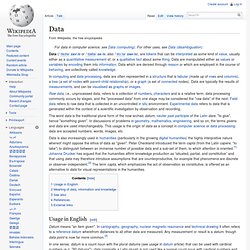

Data mining. Data. The word data is the traditional plural form of the now-archaic datum, neuter past participle of the Latin dare, "to give", hence "something given".

In discussions of problems in geometry, mathematics, engineering, and so on, the terms givens and data are used interchangeably. This usage is the origin of data as a concept in computer science or data processing: data are accepted numbers, words, images, etc. Data is also increasingly used in humanities (particularly in the growing digital humanities) the highly interpretive nature whereof might oppose the ethos of data as "given".
Usage in English[edit] Data architecture. In information technology, data architecture is composed of models, policies, rules or standards that govern which data is collected, and how it is stored, arranged, integrated, and put to use in data systems and in organizations.[1] Data is usually one of several architecture domains that form the pillars of an enterprise architecture or solution architecture.[2] Overview[edit] A data architecture should[neutrality is disputed] set data standards for all its data systems as a vision or a model of the eventual interactions between those data systems.

Data integration, for example, should be dependent upon data architecture standards since data integration requires data interactions between two or more data systems. A data architecture, in part, describes the data structures used by a business and its computer applications software. Essential to realizing the target state, Data Architecture describes how data is processed, stored, and utilized in an information system.